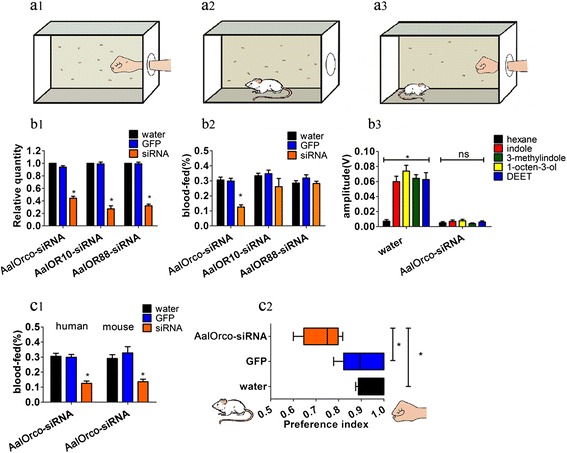Fig. 4.

Behavioral assays of RNAi-ablated mosquitoes. a1, a2 Biting assay scheme. a3 Host preference assay scheme. b1 Transcript abundance of AalORs was reduced significantly after 48 h siRNA injections (AalOR7-siRNA-treated mosquitoes: t (10) = 13.191, P < 0.0001; AalOR10-siRNA-treated mosquitoes: t (10) = 12.490, P < 0.0001; AalOR88-siRNA-treated mosquitoes: t (10) = 18.275, P < 0.0001). b2 AalOR7-siRNA-injected mosquitoes showed a significantly lower blood-feeding rate compared to the control (F (2,15) = 32.183, P < 0.0001). AalOR10-siRNA-injected mosquitoes (F (2,15) = 1.690, P = 0.218) and AalOR88-siRNA-injected mosquitoes (F (2,15) = 1.361, P = 0.286) showed no significant differences. b3 Electroantennograms of mosquito antennae stimulated with odorants. Water-injected mosquito antennae responded strongly to odorants (F (4,20) = 15.766, P < 0.0001) while AalOR7-siRNA-treated mosquitoes (F (4,20) = 0.808, P = 0.532) did not respond to any odorant. c1 Preference index for human or mouse (F (2,12) = 16.724, P = 0.002). c2 Host preference experiment. AalOR7-siRNA-treated mosquitoes showed a statistically significant lower preference for humans. (F (2,12) = 9.738, P = 0.003) (one-way ANOVA test, Tukey’s HSD tests or Dunnett T3). Bars represent the means ± SD (n = 5–7). *P < 0.05
